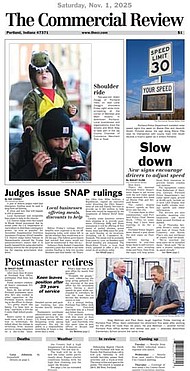July 25, 2015 at 5:26 a.m.
Portland may have in hand at least part of a solution to its downtown flooding.
While local officials are creating a committee to review flooding in Jay County, and the City of Portland specifically, a recent engineering study already addresses the problem.
A study commissioned in June 2014 by Portland Board of Works to look at flooding related to Millers Branch — a stream that runs south through the Tri-State Gas Engine and Tractor Association grounds before entering the city’s sewer system en route to the Salamonie River — was completed in May and mailed to the city last month.
“The 72-inch storm sewer going through the city is undersized,” said engineer Brian Houghton of Jones and Henry Engineers, which studied the issue and compiled the report. “Water, consequently, is going through there at such a rate that it backs up. It’s coming out of manholes. It’s coming out of the catch basins. That’s what’s causing a majority of the flooding in the downtown area.”
Houghton and hydrologist Chris Hauser will be at the Jay County Commissioners meeting at 11 a.m. Monday, along with Portland Mayor Randy Geesaman, to discuss the study and answer any questions from local officials.
Jones and Henry’s study looked at the capacity of the 72-inch sewer line into which Millers Branch currently runs, as well as the flow rates that could be expected during two-, 10-, 25- and 100-year flood situations.
Results showed that, depending on the water level of the Salamonie River, the 72-inch sewer line can handle between 100 and 200 cubic feet of water per second.
Meanwhile, during even a two-year storm, water from Millers Branch running into the sewer line peaks at 145 cubic feet per second. Those numbers increase to 343 cubic feet per second for a 10-year flood, 462 for a 25-year and 668 for a 100-year.
Therefore, even flood levels expected to occur once every two years can overwhelm the city’s sewer system. Houghton noted that the sewer line would need to be nearly doubled in size to 132 inches in order to be sufficient.
The study reviewed five possible solutions, with three being deemed viable. Those included:
•Constructing a bypass ditch from Millers Branch beginning north of the parking area at Jay County Fairgrounds just east of Morton Street. That ditch would run east about 1,200 feet and then cut south through farmland to the Salamonie River east of the city. Estimated cost: $2.14 million.
•Rerouting the water from Millers Branch beginning just north of Pearl Street. In this case, a box culvert would run east along Pearl Street, north along Morton Street and then east along Division Road. It would then empty into a new ditch near the Jay County Fairgrounds grandstand track that would run south, east and then south again through farmland to the Salamonie River east of the city. Estimated cost: $6.21 million.
•Digging a large detention basin along a bank of Millers Branch to store excess water. This would allow Millers Branch to flow at a rate up to 100 cubic feet per second into the city’s sewer system while holding the rest until water levels have gone down. Estimated cost: $7.47 million.
Houghton favors the cheapest of those possibilities as the most effective as well.
“The one that I like the best is the open ditch starting north of the fairgrounds, going east and then coming south. I think it’s the best of the options,” he said. “Until you route Millers Branch around the city — there’s some little things that we can do for Band Aids here and there, but I think that is ultimately what needs to occur.”
Each of the options would have a few hurdles to overcome, such as land acquisition for the new ditches and the fact that at least part of them would run through wetlands.
Geesaman said Friday that he had not yet presented the Jones and Henry study publicly because he wanted more explanation and clarification from the firm and had several questions about potential solutions.
Among those is whether the solutions will create a problem with higher water levels in the Salamonie River.
“I’m just afraid if we direct anything more before the Salamonie gets to the city (about) how that’s not going to (affect the river),” said Geesaman.
But Houghton said Friday that his company’s hydraulic models show that is not an issue.
“If that alternative was done and we take it around the east side of the city and discharge directly into the Salamonie River, at the 100-year storm event the worst case that we’re seeing is a quarter of an inch rise in the Salamonie River.”
That’s because the ditch wouldn’t be adding more water to the river than it already receives. It would simply be rerouting the water that currently runs into the Salamonie River around the city instead of through it.
The difference, Houghton said, is that the water would get to the river slightly faster than it does now.
Portland has had frequent flooding issues over the course of the last five years, with the most severe coming in February 2011. The city’s downtown area has been under water three times this summer — twice in June and again July 14.
According to the National Weather Service, Portland received 21.75 inches of rain — more than the annual average of 20.66 — from June 1 through July 15.
Those problems have made flood mitigation a hot topic, with Jay County Commissioners, Portland Board of Works and Portland City Council all discussing the issue Monday. The result was a decision to create a committee to look into a plan for addressing flooding in the city and county.
Faron Parr, president of Jay County Commissioners, who received a copy of the study this week, said it looks like a good starting point for the committee.
“From what I’ve seen so far, it points out some of the problem areas and points out some of the other water, where it’s coming from,” he said. “It’s a very good start to the study. But I think we’ll probably go forward with what we were talking about.”
Top Stories
9/11 NEVER FORGET Mobile Exhibit
Chartwells marketing
September 17, 2024 7:36 a.m.
Events
November
To Submit an Event Sign in first
Today's Events
No calendar events have been scheduled for today.


